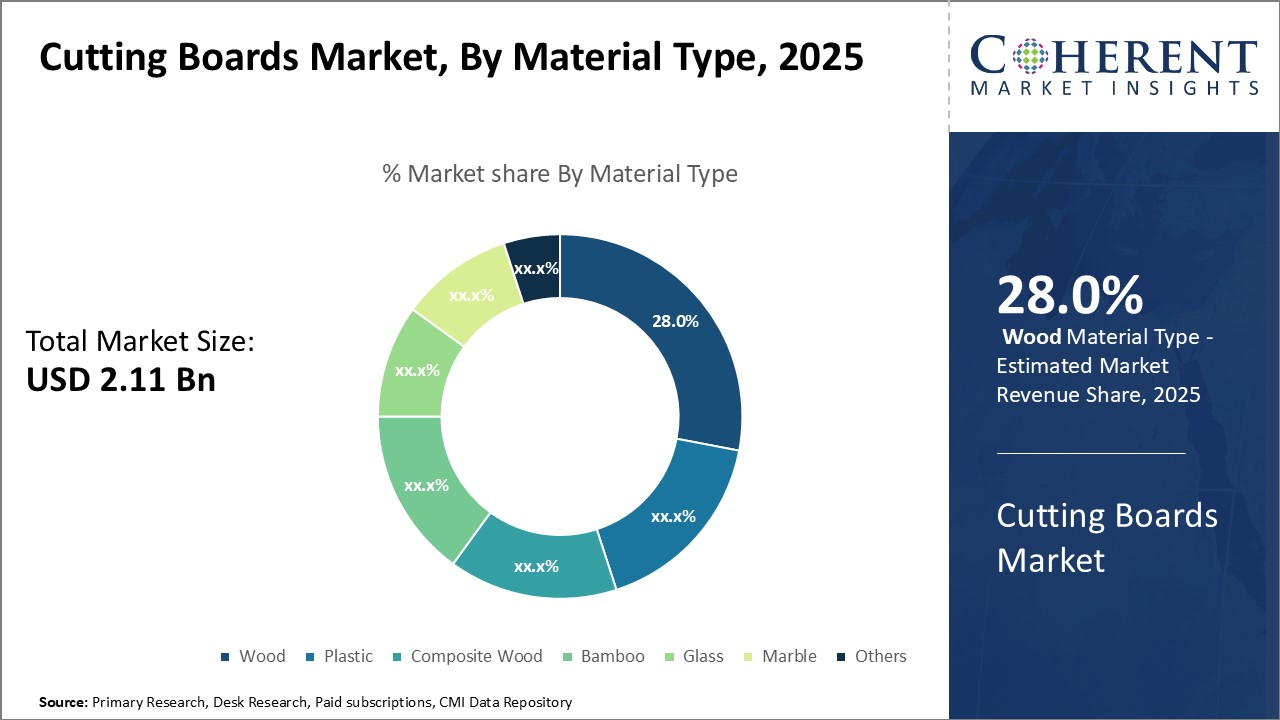Cutting boards market size is expected to reach US$ 3.22 Bn Bn by 2032, from US$ 2.11 in 2025, exhibiting a CAGR of 6.20% during the forecast period.
Cutting boards are chopping blocks used as a base for cutting fruits, vegetables, meat, bread, and other food items in domestic and commercial kitchens. These provide a stable surface to cut food items without damaging kitchen counters. Cutting boards are available in different materials like wood, plastic, glass, marble, bamboo, and others. These are an essential kitchen tool for home cooks as well as professional chefs as these protect knife edges and counter tops.
The market growth is driven by rising consumer spending on kitchenware products and growing adoption of these boards in residential and commercial kitchens. Cutting boards market is segmented into material type, end user, distribution channel, application, size, shape, and region. By material type, the wood segment held the largest share as wood cutting boards are durable, bacteria-resistant and gentle on knife edges.
Cutting Boards Market Regional Insights
- Asia Pacific is expected to be the largest market for cutting boards during the forecast period, and accounted for 35.0% of the market share in 2025. The market growth in Asia Pacific can be attributed to high consumer spending on premium and innovative kitchenware products.
- North America accounted for 25.0% of the cutting boards market share in 2025. The market growth can be attributed to expanding hospitality sector and rising residential construction in the region.
- Europe accounted for 20.0% of the cutting boards market share in 2025, due to growing demand for kitchen accessories.
Figure 1. Global Cutting Boards Market Share (%), by Region, 2025

To learn more about this report, Download Free Sample
Cutting Boards Market Drivers
- Growth of Commercial Kitchens and Hospitality Industry: The steady expansion of food service, restaurants, hotels, and other hospitality establishments has boosted adoption of cutting boards in commercial kitchens. With rising disposable incomes and urbanization, consumers are spending more on dining out, which has fueled the growth of the hospitality sector.
- Rising Popularity of Modular Kitchens: Modular kitchens are gaining immense popularity among homeowners owing to benefits like customization, efficient storage solutions, and enhanced aesthetics. The growing adoption of modular kitchens globally has led to increased utilization of built-in wooden chopping blocks that complements the stylish interiors.
- Surging E-commerce Sales: The cutting boards market has been positively influenced by the rapid growth of online sales channels. Leading manufacturers are extensively selling their products through their own websites as well as third-party e-commerce platforms like Amazon and eBay.
Cutting Boards Market Opportunities
- Customization for Specific Needs: There is an opportunity for manufacturers to provide customized cutting board solutions tailored to the unique requirements of different end user groups like professional chefs, meat handlers, pastry chefs, and others. For instance, boards with juice grooves, anti-slip feet, and thickness adjustments can be made for specific usage purposes. Companies can use computer numerical control (CNC) machines for precise custom cutting and engraving services. This can attract new customers and also enable upselling for higher profit margins.
- New Design Partnerships: Cutting board brands can collaborate with designers, fashion houses, celebrities, social media influencers, and artists to create exclusive co-branded collections with attractive designs, patterns, and shapes. This can effectively target fashion-forward millennials and Gen Z demographics. For example, the brand Material teamed up with designer Mr. Jono Pandolfi in 2020 to launch a range of colorful acrylic cutting boards. Such creative partnerships open new distribution channels and also provide marketing exposure.
- Sustainable Materials: Manufacturers have the opportunity to gain a competitive advantage by utilizing recycled plastic, reclaimed wood, bamboo, and other sustainable materials for making eco-friendly cutting boards. These manufacturers can position these products as ethical and environmentally responsible to attract consumers preferring green alternatives for their kitchens. Competitive pricing, carbon footprint labeling, transparency about sourcing and production can further enhance the appeal of sustainable boards.
Cutting Boards Market Report Coverage
| Report Coverage | Details | ||
|---|---|---|---|
| Base Year: | 2024 | Market Size in 2025: | USD 2.11 Bn |
| Historical Data for: | 2020 To 2024 | Forecast Period: | 2025 To 2032 |
| Forecast Period 2025 to 2032 CAGR: | 6.20% | 2032 Value Projection: | USD 3.22 Bn |
| Geographies covered: |
|
||
| Segments covered: |
|
||
| Companies covered: |
Epicurean, John Boos, Edward Wohl, San Jamar, SAGE, Neoflam, Catskill Craftsmen, Proteak, Carver Board, Virginia Boys Kitchens, Totally Bamboo, Lipper International, Madeira, Fackelmann, TOPULORS. |
||
| Growth Drivers: |
|
||
| Restraints & Challenges: |
|
||
Uncover macros and micros vetted on 75+ parameters: Get instant access to report
Cutting Boards Market Trends
- Multipurpose Kitchen Tools: Leading cutting board brands are expanding into kitchen prep tools like serving trays, bowl holders, compost bins, and knife blocks made from the same materials. This provides added value and convenience to customers. For instance, Ironwood launched a modular kitchen collection in 2021 comprising chopping blocks, pan handlers, paper towel holders, knife blocks, and others. This cross-selling approach boosts product bundling opportunities and average transaction value.
- High-performance Composite Materials: Technologically advanced composite cutting board materials like Richlite (paper), Epicurean (wood pulp) and Sani-Tuff (rubber) are gaining popularity for their performance benefits. These durable, knife-friendly and low-maintenance composites are widely used for commercial kitchen chopping blocks. Their microbial resistance, structural reinforcement with polymers, moisture/stain resistance make them ideal for heavy-duty foodservice applications.
Cutting Boards Market Restraints
- Volatility in Raw Material Costs: Cutting board manufacturers face margins pressures due to fluctuating prices of key raw materials like timber, plastic polymers, bamboo, glass and rubber. Costs of raw materials are heavily dependent on unpredictable supply-demand dynamics, freight costs, labor wages, environmental regulations and tariffs. Sudden price hikes of materials impact production overheads and force companies to increase finished product prices, which can adversely affect sales of these boards.
- Presence of Toxic Chemicals in Some Plastics: Certain low-cost plastic cutting boards contain bisphenol A (BPA), phthalates and other chemicals that can leach into foods during cutting and pose health risks to consumers. Despite regulations, small manufacturers continue using such toxic materials. This results in negative consumer perception regarding plastic/PVC boards, limiting adoption in some customer segments.
- Competition from Alternative Products: Cutting boards face competitive threat from alternative products like built-in chopping blocks, countertop chopping mats, flexible cutting sheets, and separate cutting tools for specific food items. Consumers, sometimes, prefer the convenience and lower cost of such substitutes. Large established brands also face competition from smaller local artisanal board makers gaining market share. Maintaining competitive differentiation is challenging for cutting board companies.
Analyst View
The cutting boards market is expected to witness steady growth in the near future driven by rising consumer preference for aesthetic and multi-functional kitchen tools. Increased adoption of sophisticated kitchen gadgets among millennials and growing importance provided to interior kitchen décor will boost demand. Innovative materials allow easier cleaning and providing anti-microbial protection is gaining popularity. Meanwhile, wooden cutting boards are finding favor among health-conscious consumers given their environment friendly nature. North America dominates cutting board sales due to growing experimentation with culinary arts in the region. However, Asia Pacific is likely to emerge as the fastest growing market as disposable incomes rise. New product launches featuring stylish designs tailored for small kitchen spaces could unlock opportunities in developing countries. At the same time, the market might experience friction from increasing adoption of multifunctional chopping boards by combining different functionalities. Cost pressures on consumers due to high inflation and economic uncertainties stemming from the pandemic may also negatively impact growth. Stricter regulations for harvesting of certain wood species like rosewood could temporarily constrain supply. Nevertheless, the introduction of sustainable substitutes crafted from alternative resources like bamboo offer potential routes for circumventing such supply-chain bottlenecks.
Recent Developments
New product launches
- In January 2022, Neoflam launched the ESSO cutting board made with antibacterial material to inhibit growth of bacteria. It provides a hygienic cutting surface for meat and poultry.
- In June 2021, John Boos & Co. introduced the commercial-grade QTZ edge grain cutting board made of end-grain wood to provide a durable surface. It is well-suited for commercial kitchens.
- In April 2020, Epicurean launched a new range of eco-friendly cutting boards made from recycled paper. The boards are knife-friendly and dishwasher safe.
Acquisition and partnerships
- In October 2022, Catskill Craftsmen was acquired by Madeira to expand its wood products portfolio with handcrafted cutting boards
- In December 2021, Proteak partnered with Williams Sonoma to supply cutting boards made of sustainable teak wood for their retail stores
- In September 2020, John Boos & Co. acquired Virginia Boys Kitchens to enhance its wood craftsmanship and expand commercial customer base
Figure 2. Global Cutting Boards Market Share (%), by Material Type, 2025

To learn more about this report, Download Free Sample
Top companies in Cutting Boards Market
- Epicurean
- John Boos
- Edward Wohl
- San Jamar
- SAGE
- Neoflam
- Catskill Craftsmen
- Proteak
- Carver Board
- Virginia Boys Kitchens
- Totally Bamboo
- Lipper International
- Madeira
- Fackelmann
- TOPULORS
- ATN Co., Ltd.
- M & D Industries
- K. Adams
- Winco
- Cozzini Bros
*Definition: Cutting Boards Market refers to the industry comprising manufacturers, suppliers, and buyers of cutting boards used in kitchens. Cutting boards provide a stable and durable surface for safely cutting fruits, vegetables, meat, and other food items. The market has grown steadily over the past few years driven by rising consumer interest in cooking and baking, trend of premium kitchenware products, and expanding hospitality sector. Key materials used to make cutting boards include wood, plastic, bamboo, glass, and marble. The market is witnessing innovation in sustainable boards, smart boards with weighing scales, antipathogenic materials, and specialized boards for meat and bread.
Few other promising reports in Consumer Goods Industry
Share
Share
Missing comfort of reading report in your local language? Find your preferred language :
Transform your Strategy with Exclusive Trending Reports :
Frequently Asked Questions
Select a License Type
EXISTING CLIENTELE
Joining thousands of companies around the world committed to making the Excellent Business Solutions.
View All Our Clients




